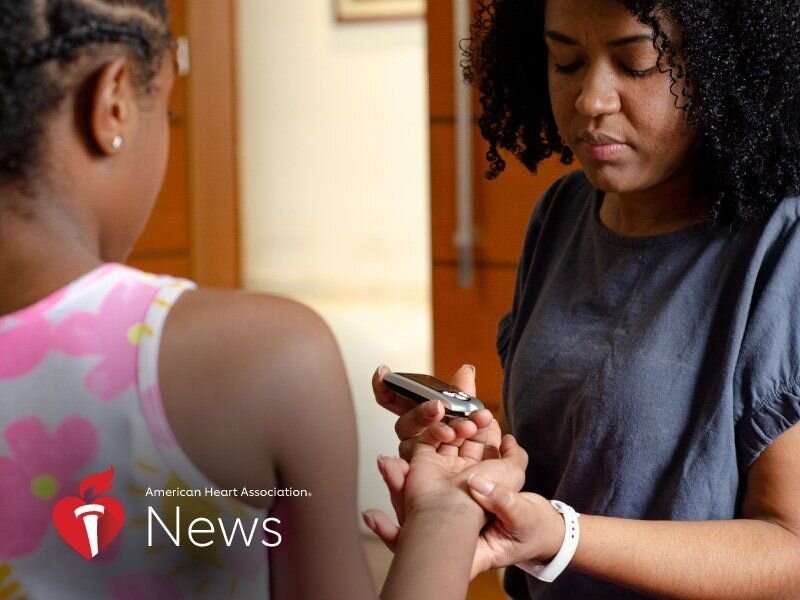This article has been reviewed according to Science X's editorial process and policies. Editors have highlighted the following attributes while ensuring the content's credibility:
fact-checked
peer-reviewed publication
reputable news agency
proofread
Explaining cardiovascular risk disparities among young people with type 1 diabetes

Black and Hispanic children with Type 1 diabetes are more likely than their white peers to develop stiffened arteries—a precursor to heart disease and stroke—during the first decade of their diabetes diagnosis, new research finds.
All of the higher risk for Hispanic children—and one-fourth of it for Black children—can be explained by socioeconomic and cardiovascular risk factors that could potentially be reduced, according to the study, published Thursday in the Journal of the American Heart Association.
"That gives us hope that there are things we can try to modify, things we can try to improve," said lead study author Katherine Sauder, an associate professor and deputy director of the Life Course Epidemiology of Adiposity and Diabetes (LEAD) Center at the University of Colorado School of Public Health in Aurora.
Blood flows much faster along stiff arteries. The increased flow and pressure of blood can negatively affect organs such as the heart. Artery stiffness typically develops in older adults but can also occur in people with Type 1 diabetes, a disease characterized by the body's inability to produce enough insulin. This type of diabetes is most often diagnosed during childhood, though it can occur at any age.
People who have Type 1 diabetes are about 10 times more likely to develop cardiovascular disease than those who don't have it. Yet research into the prevention of cardiovascular disease in people with Type 1 diabetes has been limited, and what little there is has focused largely on white people. Meanwhile, the incidence of Type 1 diabetes in the U.S., which has been rising about 2% each year since at least the early 2000s, is growing at an even faster rate among Hispanic and Black populations.
In the new study, researchers analyzed data for a racially diverse group of 1,162 children and young adults in the SEARCH for Diabetes in Youth study, which recruited participants from South Carolina, Ohio, Colorado, Washington and southern California. The children were an average 9 years old at the time they were diagnosed with Type 1 diabetes and enrolled in the study. Carotid femoral pulse wave velocity, considered the gold standard measurement of arterial stiffness, was taken after an average 11 years of follow-up.
The analysis found higher levels of artery stiffness in Black and Hispanic young people, with the biggest gap between Black and white participants. Black participants had 10% higher rates of artery stiffness than white participants.
"That sounds small, but these people are in their 20s," said Sauder, who noted that cardiovascular disease typically doesn't appear until a person's 50s. "The concern is that this gap is going to continue growing. If we can figure out why this difference is, perhaps we can intervene now and maybe there's a chance to reverse the differences that have built up in the first 10 years of their disease."
While there also was a gap in the rates of artery stiffness between Hispanic and white young adults with Type 1 diabetes, that disparity largely disappeared when the researchers controlled for cardiovascular and socioeconomic risk factors. One of the biggest modifiable factors was access to diabetes medications. Another was being overweight.
"If we could get Hispanic participants to have the same cardiovascular risk profile as their white peers, blood flow would slow down by 15%," Sauder said. "If we could get them to have the same economic profile, it would slow down by 27%."
Controlling for these factors, however, did not erase the disparities between Black and white participants.
"No matter what factors we looked at, we could only get the difference to decrease about 21%," Sauder said. "That tells us there are other things going on beyond A1C and BMI and being able to pay for your medications. There are other things driving this."
The new research "offers insight into what might be changing in cardiovascular health in the earlier decades of life for people with Type 1 diabetes," said Dr. Risa Wolf, director of the Pediatric Diabetes Center and an associate professor at the Johns Hopkins Hospital in Baltimore. Wolf was not involved in the study.
Understanding what's driving these disparities could help target critical interventions, she said.
"The more you can engage people in care early on, by increasing access to care, adherence to medications and more consistent follow-up care, the more we may be able to prevent poor cardiovascular outcomes later in life," Wolf said.
One thing the new study did not investigate was how structural racism and the stress it can cause might impact health, Sauder said.
Another factor that could be important is the use of advanced diabetes technologies, such as continuous glucose monitors and insulin pumps, to manage blood glucose levels, Wolf said. When blood glucose levels are not properly managed, the risk for cardiovascular disease increases. Recent studies, including one Wolf was involved with, have found significant racial disparities in the prescription and use of these devices among children and adults.
But Sauder said even when advanced diabetes technologies are used, some racial disparities in blood glucose control remain. "It would be great if there was an easy answer, but it's more complicated than that," she said.
Copyright © 2023 HealthDay. All rights reserved.




















